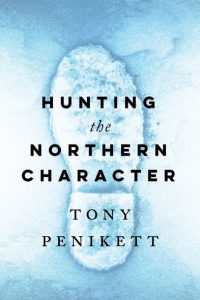The idea of provincehood for the Territories is like a magnitude 8 earthquake in the St. Lawrence River Valley. It’s inevitable and slightly terrifying for the unprepared. Mere thought of a fifth Western province at the table upsets every place setting contrived since 1867. Author Tony Penikett recalls when the Northwest Territories was pressured to comply with the Official Languages Act, the legislature sanctioned French, English – and nine aboriginal languages.
“Nowadays nobody believes that provincial status is on the horizon for Yukon, the Northwest Territories or Nunavut,” writes Penikett, former two-term Yukon premier. “For the foreseeable future, devolution of legislative jurisdiction over lands and resources may be all the northern territories can hope to get.”
Hunting The Northern Character is an eloquent appeal to end condescending treatment of the one uniquely Canada region best known to the outside world. The Arctic is famous and famously patronized. More people today live in the Northwest Territories (44,500), Yukon (38,500) and Nunavut (38,000) than lived in Manitoba when it joined Confederation in 1870 (37,000). Yet vast regions remain under federal control and Northerners in some communities must still write Ottawa for permission to build a school gym.
“When southern Canadians spare a thought for land claims or northern treaties, they tend to think of the concrete aspect of the agreements: actual land,” writes Penikett. “They pay less attention to the more abstract concept of jurisdiction. In British policy, as set out in the Royal Proclamation of 1763, land and jurisdiction go together. To hold vast lands, one must have power to make rules about their use; otherwise, what would be the point? As it happens, intellectuals in Europe, the United States and Canada have argued for centuries about whether Indigenous people have the capacity to govern and administer their own lands.”
Canadians think of the Arctic as an uninhabitable fringe of the federation. Turn the picture and it becomes the centre, explains Penikett. “Hapless media shaping means that harried policy makers may frame issues to fit outdated images of the Arctic and its peoples,” says Hunting The Northern Character. “Spare the Arctic any political leader who models him or herself on historical figures such as Sam Steele, Bishop Stringer or even Sir John Franklin, much less the fictional characters from Jack London’s White Fang or John Wayne in North To Alaska.”
“Such mystic Arctic headspaces are ungovernable,” writes Penikett. “The true North has outlived and outgrown them.”
Penikett faults federal employees who control our Arctic empire from the “air-conditioned comfort of their cubicles” in Ottawa 100 kilometres from the U.S. border, and perpetuate a “deliberately constructed self-image” of the North. The author recounts attending a wake in a Dene village, so poor it had no running water, where mourners ate moose stew and platters of salmon and bannock.
“Crow Clan servers go round the room offering the elders on the wall benches low-bush cranberry jam with their bannock,” he writes. “This feast is a celebration of one life, but also of a life lived together and of the foods gathered from tribal lands and waters around the village.”
“The situation confirms something I’ve noticed before: the poorer the community, the richer the traditional culture,” writes Penikett. “Is that some kind of law, I wonder? Does southern-model prosperity inevitable lead to northern cultural poverty?”
Hunting The Northern Character is a warm depiction of a society that endured hardship and someday will gain home rule. Wait for it. It will be upsetting and tremendous.
By Holly Doan
Hunting the Northern Character, by Tony Penikett; UBC Press; 348 pages; ISBN 9780-7748-80008; $34.95






